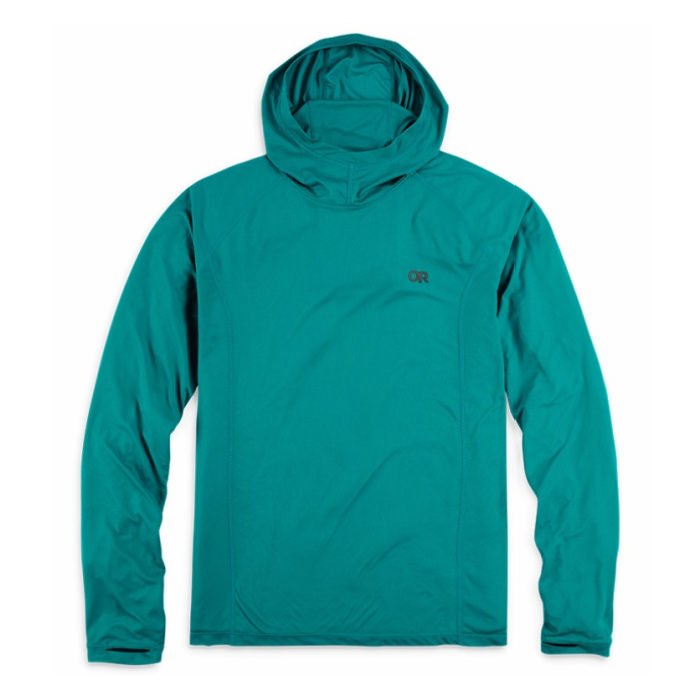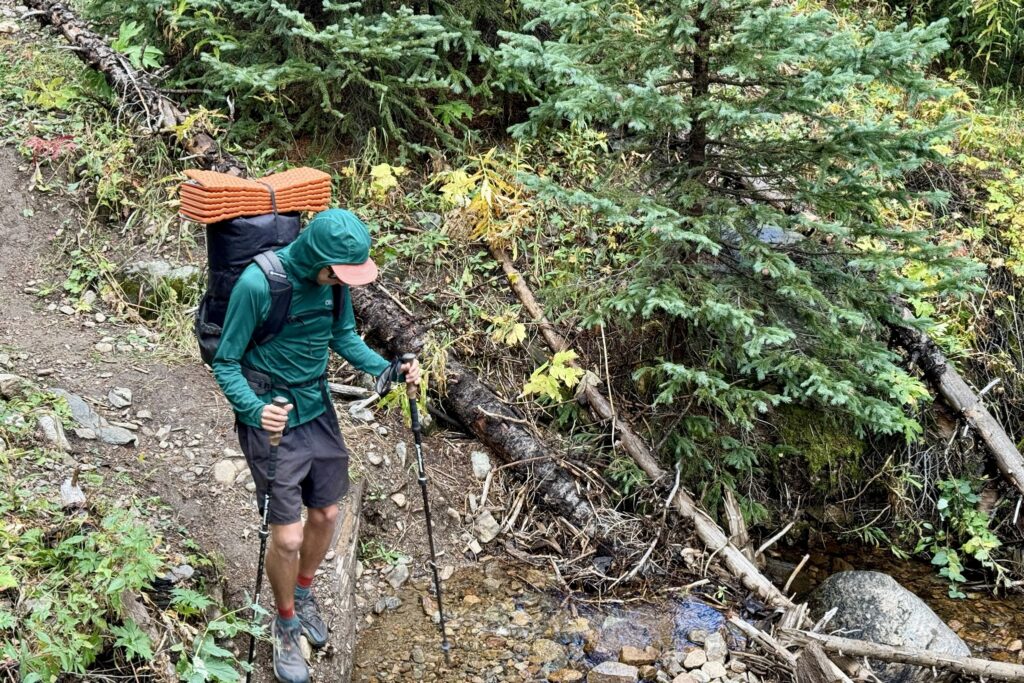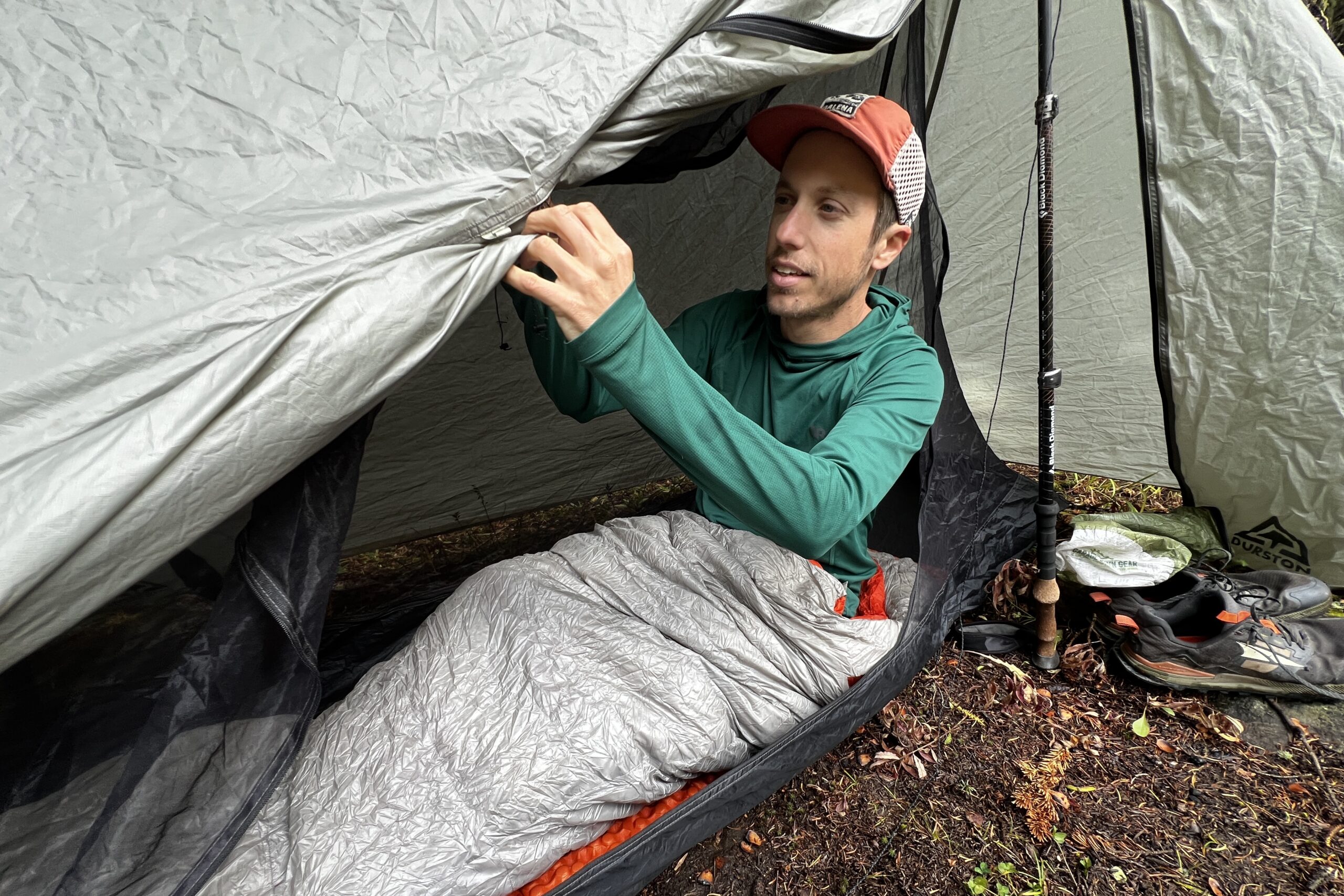Bottom Line
Can’t decide between a base layer and a sun hoodie? The Outdoor Research Echo Hoodie has you covered. It’s ultralight, comfortable, breathable, and has a UPF rating of 15, or 20 for darker colors. We tested out this shirt while scaling Colorado’s 14ers and out on the local crags to see how it would hold up against the competition.
This top is perfect for ultralight thru-hikes in warm weather. The breathable fabric keeps you cool during the heat of the day while the hood, long sleeves, and thumbholes give you full coverage to protect you from harmful UV rays. Because this hoodie is so thin and lightweight, it’s easy to layer over with a fleece or puffy jacket.
Ultralight is the name of the game with the Echo Hoodie, which means there are some sacrifices. Although it is more durable than wool, the thin fabric will wear out quicker than other synthetic base layers, especially since it’s bound to see a lot of abrasion from pack straps. It’s certainly not the warmest layer on our list of best base layers, so we recommend pairing it with a mid-layer during chilly shoulder seasons.
Quick Specs

Outdoor Research Echo Hoodie
Best sun shirt
Price:
$75
Weight:
5.2 oz.(Men’s M)
Fabric/Weight:
Lightweight polyester
Pros
- Hood
- Thumbholes
- Ultralight
- Full coverage
- Comfortable
Cons
- Lower UPF rating than others
- Not as durable
- Not very warm

Comfort
The Echo Hoodie is supremely comfortable as a sun shirt or base layer. As a standalone sun hoodie, the fit is flowy but not overly baggy. The stretchy synthetic fabric moves with you when you need it most, whether scrambling up loose talus or rappelling. Some hooded garments tend to be slightly constrictive around the neck, but the hood on the Echo Hoodie lays loose and relaxed.
The fabric is soft against the skin but also incredibly lightweight. Both are factors that make you feel like you’re wearing nothing at all with the Echo Hoodie.
Another aspect to consider in comfortability is whether or not the garment bunches up or “wedgies” when layered. When we layered a mid-layer and puffy jacket over the Echo Hoodie and tried to get it to bunch up with active movement, the hoodie moved seamlessly with the other layers. The only tricky part is finding a place to tuck the hood.

Warmth
Because it is an ultralight layer, the Echo Hoodie is best suited for summer months, hiking in full sun. While it can be used to retain some extra core heat in a winter layering system, it will likely need to be backed up with several additional layers. It could be an excellent choice for spring and fall days when the mornings are crisp, and you plan on shedding layers as the weather warms up.
Despite its ultralightness, the hood adds a warmth bonus that most base layers lack. The hood’s collar extends up to chin height, and the three-panel construction stays nice and snug around your head, helping trap heat where it escapes the most.
Although Outdoor Research lists the Echo Hoodie as a 4-season layer, it functions best from late spring to early fall in most climates.

Breathability
Breathability and moisture-wicking are the Echo Hoodie’s superpowers. Although it’s a long-sleeved shirt, it’s one of the most cooling options available, whether running a desert ultra marathon or hiking through the muggy humidity of the southeast. The ultralight synthetic fabric allows unrivaled airflow to help cool you off, dry sweat, and regulate your body temperature.
In addition to its breathability, the Echo Hoodie has excellent moisture wicking. Sweat is quickly dispersed into a thinner layer to speed up dry time. This is important because it’s uncomfortable to be soaking wet and because when the sun goes down, the remaining moisture from sweat can plummet your body temperature to dangerous levels. In a way, the breathability and moisture management of the ultralight fabric contributes to keeping you warm without having to change shirts.

Versatility
Its effectiveness as a sun hoodie and a base layer automatically makes the Echo Hoodie a more versatile shirt than other options. You could go for an entire backpacking trip without ever taking it off. It adds a bit more warmth as you start hiking in the briskness of morning, and then when things heat up, you have a breathable layer to keep you cool. You can then utilize the full coverage of the hood and thumbholes as needed. As your day comes to an end, the Echo Hoodie quickly dries and is once again a cozy base layer to sleep in.
As ultralight backpackers, we love how the features of the Echo Hoodie eliminate the need for other pieces of gear. The hood protects your ears, neck, and cheeks from the sun without needing a sun hat or extra sunscreen. With the thumbholes, the sleeves offer decent coverage for the wrists and back of the hands, eliminating the need for sun gloves. It’s not as effective for every climate and doesn’t have the highest UPF rating, but in many cases, we’ve found the Echo Hoodie to be the Swiss army knife of base layers.

Style
We wear the Echo Hoodie from the coffee shop to the trailhead to the post-hike beer. The flowy, relaxed fit looks more like casualwear than activewear, and the hoodie comes in many colorways. The fifteen color and pattern options range from vibrant neon colors to camo to dark, muted tones to ensure everyone can find something that works for them.

Should You Buy the Outdoor Research Echo Hoodie?
The Outdoor Research Echo Hoodie is an OR best-seller for good reason. It’s ideal for thru-hikers, peak baggers, fly fishers, and anyone who plans to spend a lot of time in the sun. It shines in warm weather but can add a few more degrees to your body temperature as part of a full layering system. It keeps you cool during the day, dries quickly, and layers comfortably. While we hesitate to put it to use in a winter layering system, the Echo Hoodie is an easy go-to for three seasons out of the year.
Because it is an ultralight base layer, we wouldn’t recommend it for cold-weather activities where insulation is paramount. It’s an excellent active layer that could be useful for spring skiing, but for the most part, there are better options for shredding powder or scaling up an icy waterfall.

What Other Base Layers Should You Consider?
Helly Hansen Lifa Stripe Crew: For someone looking for the ideal active layer and who isn’t as concerned about sun protection, the Lifa Stripe is a great option. It’s a synthetic active layer similar to the Echo Hoodie, minus the hood and thumbholes, but it dries quicker and retains heat a bit better.
Patagonia Capilene Midweight Crew Review: The Capilene Midweight is one of the few true 4-season base layers we readily grab all year round. It lacks some of the breathability and sun protection of the Echo Hoodie, but for adding just the right amount of warmth, it’s a base layer that fits into a layering system any time of year.
Smartwool Classic All-Season Review: The Classic All-Season is a wool competitor to the Echo Hoodie and Capilene for those who don’t like synthetics. It’s a versatile wool base layer that wicks moisture well and hits that sweet spot between warmth and breathability.


